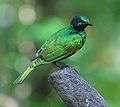Emerald starling
| Emerald starling | |
|---|---|
 | |
| Scientific classification | |
| Kingdom: | Animalia |
| Phylum: | Chordata |
| Class: | Aves |
| Order: | Passeriformes |
| Family: | Sturnidae |
| Genus: | Lamprotornis |
| Species: | L. iris |
| Binomial name | |
| Lamprotornis iris Oustalet, 1879 | |
| Synonyms | |
|
Coccycolius iris | |
The emerald starling (Lamprotornis iris) is also known as the iris glossy starling. It is a small starling with a metallic green crown, upper body, wings and tail. The ear-coverts and underparts are metallic purple. Both sexes are similar. Most taxonomists unite it with many other glossy-starlings in Lamprotornis, while others place it in a monotypic genus Coccycolius.
One of the smallest species among starlings, the emerald starling is distributed in West Africa. It inhabits lowlands and savanna of Côte d'Ivoire, Guinea and Sierra Leone.
The emerald starling feeds on figs, Haronga berries and other fruit, seeds, ants and other small insects. The cup-shaped nest is built in a tree cavity. The male and female cooperate in building the nest from leaves, and both bring food to chicks after they hatch. Females possess a brood patch—a spot on their stomach lacking feathers—that helps them transfer body heat to their eggs.[2]
It is classified as "data deficient" by the IUCN. This means that it is unlikely to be seriously threatened with extinction, but that its status in the wild is in need of assessment. In the emerald starling's case, it appears that the species is plentiful enough for the time being, but that it seems that a considerable and possibly unsustainable number of birds being caught for the cage bird trade (BirdLife International 2004). The "data deficient" status has been upheld since 2000 (BirdLife International 2007), indicative of the prolonged wars and unrest in its range which have thus far prevented comprehensive field studies.
Gallery
References
- ↑ BirdLife International (2015). "Coccycolius iris". The IUCN Red List of Threatened Species (2015). Retrieved 24 January 2016.
- ↑ "Emerald Starling Fact Sheet, Lincoln Park Zoo"
- BirdLife International (2004). "Coccycolius iris". IUCN Red List of Threatened Species. Version 2006. International Union for Conservation of Nature. Retrieved 20 July 2007. Database entry includes justification for why this species is data deficient
- BirdLife International (2007): Species factsheet: Coccycolius iris. Retrieved 2007-JUL-20.



